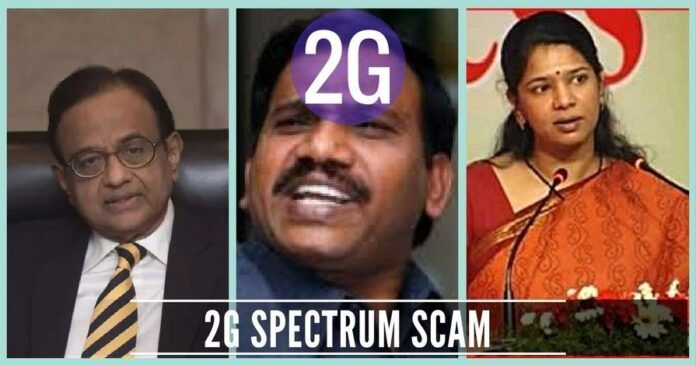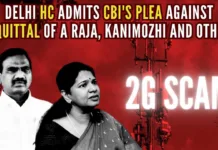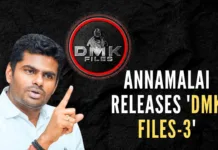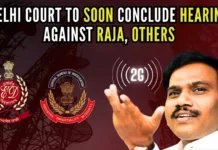
As the Trial Court is about to deliver judgment on December 21, we are bringing you a blow-by-blow description of this gigantic scam which shook the Nation about ten years ago. We recommend that you stay calm and take a walk before resuming, if your blood starts boiling.
Raja wanted to grant licenses on a First-Come-First-Served basis (but in a peculiar way – who pays the license fee first and not who first applied) and at the prices fixed in 2001.
-
- A Raja becomes the Union Minister for Environment and Forests in May 2004 and shifts to Ministry of Communications and IT on May 16, 2007. Real estate companies that were friends of Raja wanted to become telecom operators and he informs his decision to the then Telecom Secretary DS Mathur for granting new licenses and spectrum to new players. But Mathur objects and argues for transparent auction and competitive pricing (as recommended by the Telecom Regulatory authority of India (TRAI) from 2003 onwards and the Cabinet decision of Oct 2003 which insists on an auction). Raja wanted to grant licenses on a First-Come-First-Served basis (but in a peculiar way – who pays the license fee first and not who first applied) and at the prices fixed in 2001. In 2001, there were only 4 million mobile subscribers and that had ballooned to 350 million by mid-2007. Manju Madhavan, Member (Finance) of Department of Telecommunications (DoT), Finance Secretary D Subbarao also pointed out new competitive prices and argued for having an auction. But Raja ignored all their suggestions and sent the file to the Law Ministry for their opinion and started the ball rolling in September 2007.
- On September 24, 2007 DoT issues a press release (released late in the evening and appeared next day in the newspapers), citing the last date of application (cut-off date) as October 1, 2007.
- Meanwhile without getting the approval of Cabinet, Raja allots Dual Policy or Cross Technology to Reliance Communications, Tata Teleservices and Shyam Telecom in October 2007 at 2001 rates. This technology allows Code Division Multiple Access (CDMA) operators to change to the much wanted Global System for Mobiles (GSM) Technology. CDMA operators were in a bad shape and Raja’s decision had come as a boon to them. The corruption that occurred was on allowing the much wanted GSM license at a six year old price. This move was Raja’s first instance of major corruption in Telecom, and this gave him the courage to go ahead with 2G Spectrum allocation to new companies.
- On Nov 1, 2007, Law Minister HR Bhardwaj rejects Raja’s plan and directs to constitute an Empowered Group of Ministers (eGoM) to formulate transparent procedures for 2G Spectrum allocation and new licenses.
- The following day, i. e. Nov 2, 2007, by 8 PM, Raja wrote a letter to Prime Minister (PM) Manmohan Singh, objecting to Bhardwaj’s direction. “Law Ministry is out of context,” wrote Raja. This letter was delivered to PM’s residence by late night.
- Within an hour, i. e. at around 9 PM, on the same day (Nov 2, 2007), perhaps alerted by Bhardwaj – PM wrote to Raja to stop all procedures and directs him to get his concurrence in all future actions. This letter was delivered to Raja’s residence. Citing several wrong practices in the past, PM directs Raja to adopt a transparent method by auction and new pricing.
- By midnight, Raja gave an evasive reply to the PM, hushing up the directions for auction and competitive pricing. This letter was also dated Nov 2, 2007 and was delivered at the PM’s residence at around midnight itself.
Finance Secretary D. Subbarao wrote to the Telecom Secretary Mr. DS Mathur on November 22, 2007 – objecting to the pricing policy of 2G Spectrum and argued for auction.
-
- The then Solicitor General Ghulam Vahanvati, who was caught for providing many a convenient opinion and reverse opinion on the same subject, was present in Raja’s residence on Nov 2, 2007 from 7 PM to 11:30 PM. He drafted the two letters written to the Prime Minister by Raja. He was elevated in UPA-2 due to his nexus with all unholy elements in politics and corporate world. Here the top law officer was giving opinions against the Law Minister!
- Finance Secretary D. Subbarao wrote to the Telecom Secretary Mr. DS Mathur on November 22, 2007 – objecting to the pricing policy of 2G Spectrum and argued for an auction based process. In the letter, the Finance Secretary objected to the dual policy (cross technology) implemented (Oct 2007) to help CDMA operators like Reliance and TATA to more revenue earning GSM technology at the cheap 2001 rate, without cabinet approval.
- Regarding this controversial allotment of dual policy (this was Raja’s first big corruption in Telecom Ministry), in the November 2, 2007 late night letter, the PM said to Raja: “I came to know through the media on the allotment of dual policy or cross technology”. The Comptroller and Auditor General (CAG) report said that around Rs.36,000 crores ($6 billion at 1 USD = Rs. 60) were lost over this allotment of dual policy which benefited mainly Anil Ambani’s Reliance and TATA.
- Strong resistance by Telecom Secretary DS Mathur and Manju Madhavan prevents Raja from moving ahead. For suggesting a series of steps for auction, Raja snubs Manju Madhavan, in an internal note dated Dec 4, 2007. Manju Madhavan took Voluntary Retirement Scheme (VRS) soon afterwards.
- After 50 days, on Dec 26, 2007, Raja wrote a letter to PM, saying that he was “further enlightened” by Pranab Mukherjee (the then External Affairs Minister) and G Vahanvati (the then Solicitor General) to go ahead with “pre-emptive and pro-active” decision to allot 2G Spectrum and new licenses. In these letters also Raja argues for reversing the cut-off date to limit the players. PM did not reply, but simply gave a routine acknowledgement on Jan 3, 2008.
- On Dec 31, 2007, DS Mathur retires. Raja brings his trusted man Siddharth Behura as the new Telecom Secretary, who worked as an Addl. Secretary with him in the Ministry of Environment and Forests. Within 10 days (Jan 10, 2008) at 2:45 PM, the DoT uploads a press release saying that cut-off date was brought forward from October 1, 2007 to September 25, 2007. The press release asked the new players to remit fees (huge amount of money ranging from Rs.1000 crores – Rs.1651 crores) between 3:30 PM – 4:30 PM on the same day. It is a mystery as to how these nine new companies remitted this huge fees by demand draft within 45 minutes! The CAG Report exposed the fact that all these companies were ready with Demand Drafts a few days before the event.
Chandolia asks official to collect the application and demand draft from the two CEOs and directs to give No: 1 status to Swan and No: 2 status to Unitech.
- Here is the conspiracy angle. All the nine company owners/ brokers had a meeting with Raja on Jan 9, 2008 at his residence. All were informed by the Minister 24 hours before the issue of press release. The cut-off date was reversed to September 25, 2007, because Raja’s favourite company Unitech had applied on Sept 24. Another favourite company of his, Shyam Telelink also applied on Sept 24.
- On Jan 10, 2008, the CEOs of Swan and Unitech (most favoured companies of Raja) sat at Private Secretary RK Chandolia’s cabin in Sanchar Bhavan. Deputy Director General (DDG) Access Service (AK Srivastava) directs officials to go Chandolia’s cabin at 3 PM. Chandolia asks the official to collect the application and demand draft from the two CEOs and directs him to give No: 1 status to Swan and No: 2 status to Unitech. Only after that was the counter opened at the eighth floor of Sanchar Bhavan to receive application/ fees from the other seven companies. There was a mad rush to become the first in the queue and a physical fight ensued between rivals. Bouncers were brought in. The CEOs quarrelled with each other and some telecom officers were also manhandled. Though the police arrived, no case was registered upon the instructions of Chandolia.
- Objecting the dramatic and dubious allocation of 2G licenses, the TRAI Chairman Nripendra Misra wrote to the Telecom Secretary Siddharth Behura on January 14, 2008. He objected to the dubious method of allocation, reversal of cut-off date and manipulation of his recommendations. Later, in the media, Misra described that DoT had “cherry picked” his recommendations.
- As per the Sec 11(1)(a)(ii) and Sec 11(1)(d) of the TRAI Act, DoT is mandated to get the recommendation of TRAI, if they are to issue licenses to new operators. But Raja never sought the recommendation of TRAI when he allotted license to new operators like Swan Telecom, Unitech group of companies (they changed the name to Uninor), Loop Telecom (license was granted in the name of Shipping Stop Dotcom India Pvt Ltd!!), Datacom floated by Mahendra Nahata – subsequently changed the name to Videocon, STel owned by DMK linked businessman Sivasankaran and Allianz Infra (merged/ amalgamated with Etisalat later with their license in 2 circles). Little known Allianz Infra was owned by Ajay Singh, Officer on Special Duty (OSD) of former Telecom Minister Pramod Mahajan and the current owner of Spice Jet.
- DoT allots spectrum/ licenses including additional spectrum to existing players to cool tempers in March/ April 2008. All files were signed by Raja. Unitech applied licenses in different names – Unitech Infrastructure, Unitech Builders and Estates, Aska Projects, Nahan Properties, Hudson Properties, Volga Properties, Adonis Projects and Azare Properties. Later Unitech Group forms eight companies – Unitech Wireless (Tamil Nadu), Unitech Wireless (North), Unitech Wireless (South), Unitech Wireless (Kolkata), Unitech Wireless (Delhi), Unitech Wireless (East), Unitech Wireless (Mumbai), Unitech Wireless (West).
- A dubious order was issued by Siddharth Behura on April 22, 2008 for facilitating merger (leaving the word acquisition). This helped Unitech to merge all their licenses and helped all to waive the mandatory three year lock-in-period in selling of their shares.
- On Sept 13, 2008, Raja forces Bharat Sanchar Nigam Limited (BSNL) Chairman and Managing Director (CMD) Kuldip Goyal to enter into a unprecedented Memorandum of Understanding (MoU) with Swan, known as Intra-Circle Roaming Agreement. This MoU would help Swan to use all infrastructure (Towers, optical network etc) of BSNL. This MoU was executed just a week prior to Swan’s Rs.4500 cr. deal (sale of 45 percent shares) with Etisalat. Swan gave an unsolicited application to BSNL. The BSNL management committee demands 52 paise/ call from Swan. But this clause was absent in the MoU. Raja also transfers senior officials in the Wireless Planning and Co-ordination Wing (WPC) (Joint Wireless Adviser RJS Kushwaha and Deputy Wireless Adviser D Jha) for objecting to Swan’s proposals to BSNL and DoT.
- In Sept/ October 2008 – Swan offloads 45 percent shares to UAE based Etisalat for Rs.4500 cr. (Swan got the license for Rs.1530 cr). Etisalat invested into Swan through its Mauritius unit. Swan was actually owned by Anil Ambani’s Reliance Group, which was not supposed to apply for telecom licenses. Only one company from a group was allowed to apply in the telecom sector to prevent monopoly. Anil Ambani exchanged (assigned is perhaps more appropriate) Swan to Shahid Balwa and Vinod Goenka under the instructions of Raja. Meanwhile, Anil Ambani’s group illegally, in a covert way, kept shares in Swan which was caught by the CAG and the Central Bureau of Investigation (CBI). Swan’s shareholding pattern was totally mysterious. Swan was owned by many shell companies with zoological names such as Tiger Trustees, Cheetah Financial, Penguin Holdings, Zebra Consulting etc.
- Unitech offloads 60 percent of shares to Norway based Telenor for Rs.6200 cr. (Unitech got license for Rs.1651 cr). Telenor invested through its South-Asia division. Telenor is a major operator in Pakistan and Bangladesh and Indian security agencies for a long time prevented this deal. But later on, when Chidambaram became the Home Minister, this deal was approved.
- On Nov 4 2008, Swan informs DoT that – it allotted Rs.380 cr. worth shares (9.9%) to a Chennai based newly floated company Genex Exim. This is believed to be a kick back from Swan to Raja. Genex was incorporated on September 17, 2008. This shell company was represented by Ahmed Syed Salahuddin (32) on the board of Swan. Ahmed Syed Salahuddin is the younger son of Syed Mohammed Salahuddin, a Non-Resident Indian (NRI) business tycoon heading the Dubai-based real estate conglomerate, ETA Ascon Star Group, which is very close to the Dravida Munnetra Kazhagam (DMK) leadership.
- ETA Group had several real estate projects cleared during Raja’s stint in Environment Ministry. More over the ETA owner Syed Mohammed Salahuddin had a four-decade long association with Tamil Nadu Chief Minister M. Karunanidhi. Most of the flyovers, new Secretariat complex were built by this man, who was also a distributor of Karunanidhi’s films. Star Health Insurance, also owned by this man, is running the state government’s group health insurance scheme. Salahuddin was also named in Justice Sarkaria Commission report in 1976. The Commission was instituted by Prime Minister Indira Gandhi, after dismissing Karunanidhi for gross corruption.
- The CAG found that of the total of 122 licenses given, Swan (13), Unitech(22), Loop(21), Datacom(21), STel(6) and Allianz Infra (2) were totally illegal according to DoT guidelines itself, apart from violations in the Companies Act. The CAG tabled the report in Parliament on November 16, 2010 – finding a presumptive loss of up to Rs.1.76 lakh crores due to the illegal allotment of 2G spectrum including the Dual Policy.
- The CBI found that from Swan Telecom linked firms, Rs.214 crores were given to DMK controlled Kalaignar TV as kickback and Karunanidhi’s daughter Kanimozhi was behind this. According to CBI, controversial lobbyist Niira Radia was also behind the allotment of 2G licenses to many companies and was involved in the sale of these companies to foreign firms.
Legal Battles:
- In November 2008, Subramanian Swamy filed a complaint to Prime Minister Manmohan Singh seeking Sanction for the prosecution of Raja.
- STel owner Sivasankaran also filed a case and won it in Delhi High Court in late 2009 and then in the Supreme Court he withdrew (!) the case. But the Delhi High Court Judgment describing the 2G allocation as dubious was not stayed due to the intervening petition of BJP leader Subramanian Swamy, accusing adjustment between Sivasankaran and Telecom Minister A. Raja.
- On the direction of the Chief Vigilance Commissioner (CVC), the CBI registers a First Information Report (FIR) in the 2G Spectrum Scam in October 2009 without mentioning any names and conducted raids at the DoT Head Quarters, Sanchar Bhavan. CBI actions were frozen after DMK put pressure on Congress.
- Subramanian Swamy approached the Delhi High Court (DHC) in May 2010 complaining of non-action by the then PM Manmohan Singh on his series of petitions for Sanction for Prosecution from 2008 onwards. But the DHC in July 2010 rejected the petition, based on the CBI argument that they were investigating the case. Swamy also filed another petition for the cancellation of the entire set of 122 licences citing a series of violations. The DHC rejected Swamy’s petition on technical grounds suggesting that there were some errors in the petition but giving Swamy the liberty to file again in July 2010.
- Delhi High Court also rejected Prashant Bhushan’s petition demanding a probe in the 2G Scam citing the role of Niira Radia in telecom licence allotment in July 2010.
- Meanwhile the auction of 3G and Broadband Wireless Access (BWA) Spectrum earned Rs.1.06 lakh crores and agitations started in many quarters.
- In September 2010, a Supreme Court Bench comprising Justices GS Singhvi and Ashok Ganguly issues notices to Telecom Minister A. Raja, the Government, CBI and Income Tax on Prashant Bhushan’s appeal. Subramanian Swamy also joins in September 2010, and files an appeal on PM Manmohan Singh’s failure to decide on Sanction for Prosecuting Raja and the cancellation of 122 licences. Prashant Bhushan and Subramanian Swamy demanded Supreme Court (SC) monitoring and the SC agreed in October 2010. From this moment the UPA Government started shaking.
- The CAG submitted a report on the 2G Spectrum Scam describing a loss of Rs.1.76 lakh crores to the exchequer on November 8, 2010. Raja was forced to resign on November 14, 2010.
- In December 2010, Supreme Court started direct monitoring of the 2G Scam and appointed Investigating Officers for CBI and Enforcement Directorate and established Special 2G Court to work on a daily basis and banned all other courts from interfering into 2G Scam related matters. OP Saini was appointed as Special Judge of the 2G Court. The Apex Court also appointed senior lawyer UU Lalit as Special Public Prosecutor (SPP). Later in 2014, Anand Grover was appointed as SPP, when UU Lalit was elevated as a Supreme Court Judge.
- In February 2012, the Supreme Court cancelled all the 122 licences allotted during the 2G Scam and ordered for auction of all natural resources in future. UPA Government went for a Presidential Reference against the SC verdict. The five member Bench headed by Chief Justice SH Kapadia ratified the SC verdict and directed that all natural resources be allotted through auction only.
- This was replicated in the Coal Scam Judgment which too cancelled all licenses and directed for auction of coal mines.
- Raja allotted 122 licences for a paltry amount of Rs.9200 crores. The auctions from 2010 to 2016 gave the government Rs.3.6 Lakh crores from the Telecom spectrum allotment.
- NIA confiscates Pak-harboured Khalistani terrorist Lakhbir Singh Rode’s key aide’s land in Moga - April 19, 2024
- Prime Minister Narendra Modi: A Gujju businessman who does not invest his precious time for a losing battle - April 13, 2024
- NIA arrests two accused Shazib and Taahaa in Bengaluru’s Rameshwaram Cafe blast case from Kolkata - April 12, 2024











[…] Spectrum Scam: 1,76,000 Crore scam took place during the UPA era and so many high profile people (Including a Cabinet Minister) in the […]
[…] What is 2G Spectrum Scam? A Ready Reckoner – Dec 20, 2017, […]
Sorry Mr.Ravishankar Venkataraaaman – the Rahul Congress has got power to direct the Lord Shiva to renew their political licence for further LOOT.
SHAME. TODAY VERDICT
SHAME. ALL ARE ACQUITTED TODAY.
Brilliant!. Simply brilliant. Kudos and thanks. The article should motivate young journalists more and more to get into serious, investigative financial journalism, rather than perennially tracking politics and the petty issues involved in politicking, which do not affect the nation’s economic future. In fact, time has come for our media, both print and electronic, to concentrate their front page to the economic issues of our country.
Typo: “The CAG submitted a report …. 1.76 crore”, it should be 1.76 lakh crores.
It was missed in one place. Thanks for pointing it out. Corrected now.
Million dollor question is can Indian govt recover the looted amount. unfortunately no because Modi is quiet..
Form the entire post you could only figure out Modi is silent.
awesome Iyer Sir…
Excellent analysis. Hope all the crooks are sent to jail tomorrow.
I read with interest this article …. NO a ball by ball (with time line )commentary on the way Raja threw to winds all the set procedures of the government causing untold loss to exchequer. Thanks to Vigilant politician like Dr Swamy this massive scandal would have not seen the public light. More than Raja and Chidambaram , i would blame then PM Manmohan singh to be a silent spectator for all this . He went to the extent of coining a term as ‘Coalition Dharma’ for his governments organised LOOT. The people of India will never forgive Congress for its MISDEEDS.
Keep up the good work Team Gurus and raise the professional bench mark on Journalism with accurate and impartial reporting. DHARMA SHALL TRIUMPH.
Ur karma follows everywere. Manmohan Singh had nothing to do with country, he was only in the house to serve that bitch Antonio maino n her clan. This scam was a security danger for India too.
Raja was forced to resign on Nov 14, 2010. But mistakenly you have written November 14, 2014.
Good catch. Corrected.